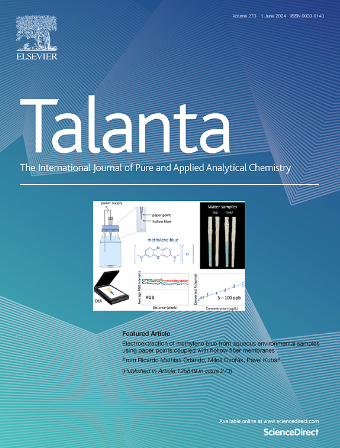A near-infrared ratiometric fluorescent probe for ferroptosis related hydrogen polysulfides imaging in arthritis
IF 6.1
1区 化学
Q1 CHEMISTRY, ANALYTICAL
引用次数: 0
Abstract
Hydrogen polysulfide (H2Sn, n > 1) is considered a highly promising new signaling molecule that plays an irreplaceable key role in physiological regulation. Ferroptosis is primarily driven by iron-dependent accumulation of lipid peroxides related to reactive oxygen species under the action of iron. During the process of ferroptosis, large amounts of ROS are produced, which promote an increase in intracellular levels of hydrogen polysulfide. There are studies indicating a close and undeniable association between ferroptosis and arthritis. Based on this, our study synthesized a near-infrared ratiometric fluorescent probe TMN-S4 for in vivo and in vitro detection and imaging of H2Sn. TMN-S4 exhibits high sensitivity (DL = 0.38 μM) and selectivity towards H2Sn, and cytotoxicity assays have shown that it has low biological toxicity and good biocompatibility. The nucleophilic substitution mechanism between the probe and H2Sn was verified through spectroscopic experiments and NMR analysis, and the probe TMN-S4 has been effectively used for track and image endogenous and exogenous H2Sn sources in cells. In addition, the probe monitored the changes in intracellular H2Sn expression levels during ferroptosis in a ratio signal mode. More importantly, TMN-S4 successfully achieved imaging of H2Sn in arthritis mice associated with ferroptosis. This provides an effective experimental tool for a deeper understanding of the mechanism of action of H2Sn in arthritis caused by ferroptosis.

近红外比例荧光探针用于关节炎中与铁下垂相关的多硫化氢成像
多硫化氢(H2Sn, n >;1)被认为是一种非常有前途的新型信号分子,在生理调节中起着不可替代的关键作用。铁下垂主要是由铁作用下与活性氧相关的脂质过氧化物的铁依赖性积累引起的。在铁下垂过程中,产生大量ROS,促进细胞内多硫化氢水平的增加。有研究表明,铁下垂和关节炎之间的密切和不可否认的联系。在此基础上,本研究合成了一种近红外比例荧光探针TMN-S4,用于体内和体外对H2Sn的检测和成像。TMN-S4对H2Sn具有较高的敏感性(DL = 0.38 μM)和选择性,细胞毒性实验表明其具有低的生物毒性和良好的生物相容性。通过光谱实验和核磁共振分析验证了探针与H2Sn之间的亲核取代机制,并且探针TMN-S4已被有效地用于细胞内源和外源H2Sn的跟踪和成像。此外,探针以比值信号模式监测铁下垂期间细胞内H2Sn表达水平的变化。更重要的是,TMN-S4成功实现了与铁下垂相关的关节炎小鼠的H2Sn成像。这为深入了解H2Sn在铁下垂性关节炎中的作用机制提供了有效的实验工具。
本文章由计算机程序翻译,如有差异,请以英文原文为准。
求助全文
约1分钟内获得全文
求助全文
来源期刊

Talanta
化学-分析化学
CiteScore
12.30
自引率
4.90%
发文量
861
审稿时长
29 days
期刊介绍:
Talanta provides a forum for the publication of original research papers, short communications, and critical reviews in all branches of pure and applied analytical chemistry. Papers are evaluated based on established guidelines, including the fundamental nature of the study, scientific novelty, substantial improvement or advantage over existing technology or methods, and demonstrated analytical applicability. Original research papers on fundamental studies, and on novel sensor and instrumentation developments, are encouraged. Novel or improved applications in areas such as clinical and biological chemistry, environmental analysis, geochemistry, materials science and engineering, and analytical platforms for omics development are welcome.
Analytical performance of methods should be determined, including interference and matrix effects, and methods should be validated by comparison with a standard method, or analysis of a certified reference material. Simple spiking recoveries may not be sufficient. The developed method should especially comprise information on selectivity, sensitivity, detection limits, accuracy, and reliability. However, applying official validation or robustness studies to a routine method or technique does not necessarily constitute novelty. Proper statistical treatment of the data should be provided. Relevant literature should be cited, including related publications by the authors, and authors should discuss how their proposed methodology compares with previously reported methods.
 求助内容:
求助内容: 应助结果提醒方式:
应助结果提醒方式:


